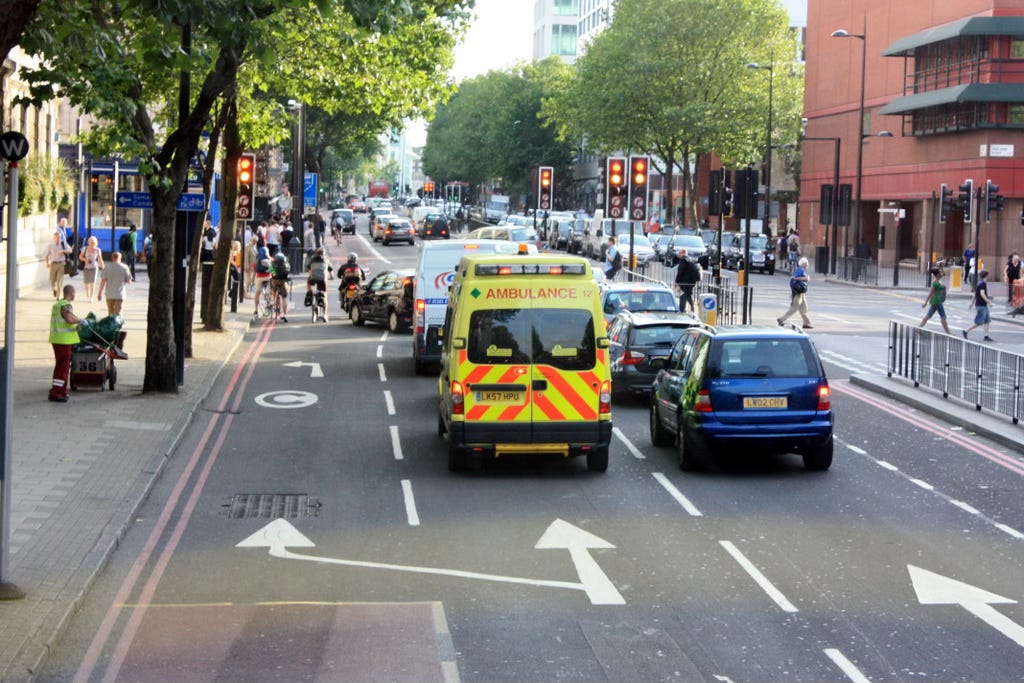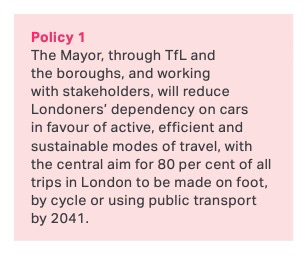Looking at the Mayor’s Transport Strategy through a car windscreen
If Sir Sadiq succeeds, there’ll be a huge change in how London’s transport system works - story 30
Reducing car dependency, particulary private car use, is key to the Mayor of London’s 2018 Transport Strategy (MTS).

Reducing car dependency is ‘Policy 1’ in the Strategy.
But for all the hostility towards this goal - and there’s a lot, I am looking at you, Bladerunners - this is a means to an end.
MTS wants to shift the make-up of the entire transport system towards what it describes as ‘sustainable, efficient, and active travel’. And to do that, Mayor Khan must reduce our dependency on (private) cars.
MTS on all vehicles
It is worth restating the key aims of the strategy as they relate to vehicles of all types
Mode shift: increasing the proportion of trips made by walking, cycling, and public transport to 80% by 2041 (up from 63% in 2018).
Private Cars: the strategy explicitly aims to reduce reliance on private cars, particularly for short trips, especially single-occupancy vehicle travel. I have written before about car right, right car
Road space reallocation: encouraging more efficient use of road space, including bus lanes, cycle lanes, and pedestrianised areas.
Vehicle reduction versus cleaner vehicles: MTS focuses on reducing overall vehicle numbers, but it also supports a shift to cleaner vehicles (e.g., electric, zero-emission freight).
Congestion and pollution: policies like Ultra Low Emission Zone (ULEZ) expansion and road pricing are designed to reduce congestion and air pollution, not just reduce cars.
Other Vehicles: The strategy acknowledges the need for some essential vehicles (e.g., buses, taxis, freight, emergency services) but aims to reduce their emissions and improve efficiency.
Freight & Deliveries: Encouraging consolidation and off-peak deliveries to reduce overall vehicle numbers.
I will go into these topics in more detail, especially as they relate to Barnes and surrounding area. Road space allocation for example is freighted with animosity. As for congestion..
Changing this dependency on cars is key to the whole strategy. Remember, it is Policy 1.
Still processing this Strategy
A near 10% reduction in cars by 2041 will lead to a near 33% increase in the number of trips made by walking, cycling and public transport. That didn’t add up at first. But that private car will likely be used several times - several trips - in any given period of time, say a month.
I then looked again at the car reduction target, 9.4% over 25 years. Applied to Hammersmith Bridge, that means 20,000 cars everyday not 22,000. It doesn’t seem a huge difference. But if you love your car, if you are used to making all those trips, short and long, any reduction is a big reduction.
I will return to the mode shift again. Looking at the ambition as I write this in 2025, it seems a big ask.

